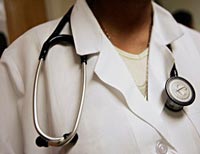Making Sense of Healthcare ‘Brain Drain’

 |
| An African medical Practitioner |
The number of places available to train doctors at SA’s eight medical schools is determined by the Health Professions Council of South Africa and is limited to a maximum of 1,226 positions each year. This situation has remained unchanged since the 1970’s despite the fact that the demand for these positions increases every year. In 2006, it was estimated that 15,794 prospective students applied for these coveted positions.
The immediate response to alleviate the chronic shortages of medical personnel would be to let skilled foreign health professionals practise in SA. However, the SA government has set itself the ill-conceived target of a maximum of 5 per cent of SA’s medical workforce to consist of foreign doctors. It is estimated that currently 15 per cent of the workforce is foreign. Compare this to the United States where it is estimated that 25 per cent of practising doctors are trained abroad. The majority of foreign doctors in SA work in rural areas – without them it is likely that the rural system would collapse. Although there is not a specific estimate of what it costs the government to put an individual through medical school, the general consensus is that it costs in the region of R2 million per doctor. In contrast, it costs approximately R100,000 to recruit a foreign doctor.
SA has taken the stance that there shall be, “No active recruitment for permanent employment in South Africa [from]… other developing countries in the African region”. The attempt to restrict the flow of health professionals from our fellow African neighbours is well intentioned. However, OECD countries and other struggling developing countries will be more than happy to absorb these health professionals into their systems, and SA patients will be the ultimate losers.
The SA government not only restricts entry for foreign doctors but also places various other restrictions and conditions on their terms of employment. Foreign doctors and other health professionals may only work for a period of three years or less and those who do not enjoy permanent resident status are not permitted to enter private practice.
The shortage of trained medical personnel is not limited only to SA. The World Health Organisation estimates that there is a worldwide shortage of 4.3 million health workers. Rather than acknowledging the worldwide shortage, SA’s ex-Minister of Health, Manto Tshabalala Msimang, stated earlier this year, “Rich countries should not undermine the health systems of poor countries by poaching their workers. The continued illicit recruitment of health workers by the developed countries should stop”. Doctors and nurses who decide to leave their homes and work elsewhere cannot be blamed for the situations they leave behind. The free movement of labour is a fundamental and inalienable right of individuals.
The SA government’s response to address the skills shortages is to substantially increase the remuneration of public health sector professionals. Although this may sweeten the conditions for existing professionals working in the public health sector it does not sufficiently address the root of the problem namely increasing the supply of doctors. Moreover, SA is in no position to win a bidding war against developed nations for these scarce resources.
A long-term strategy to alleviate the chronic staff shortages would require the government, and more specifically, the Department of Education, to relax the controls on tertiary education facilities, make entrance to these facilities less restrictive, and allow the private sector to provide a large percentage of tertiary medical education for doctors. The private medical schools could operate on either a for-profit or non-profit basis. If private education facilities are established they have the potential to relieve a significant part of the burden currently faced by the public sector.
Consider the progress that has been made in the training of nurses. With closure of many of the public sector nursing colleges in the 1990’s severe shortages ensued. According to the Private Hospital Review a total of 2,629 registered nurses graduated from these public sector facilities in 1996, ten years later this figure plummeted to 1,493. But the private hospital sector in SA has been investing significantly and intensively in both the financing and training of nurses in order to try and fill the gap. According to the South African Nursing Council in 2006 the private sector funded and trained approximately 54 per cent of registered nurses who qualified in SA.
If the SA government allowed the private sector to train doctors and stopped artificially restricting the supply of skilled health professionals we could begin to see the situation improve. SA private hospitals are well-established centres of excellence and world-renowned for their high levels of care. Privately run education facilities, if conducted in co-operation with private hospitals, have the potential to attract a significant number of internationally recognised lecturers, which will increase the available pool of knowledge, as well as international students, who will potentially remain to work in SA. Privately run medical schools will not solve the chronic medical staff shortage overnight but will assist the government’s long-term efforts to increase the numbers of medical professionals in SA.
By Jasson Urbach, Economist with the Free Market Foundation and a director of Africa Fighting Malaria.
